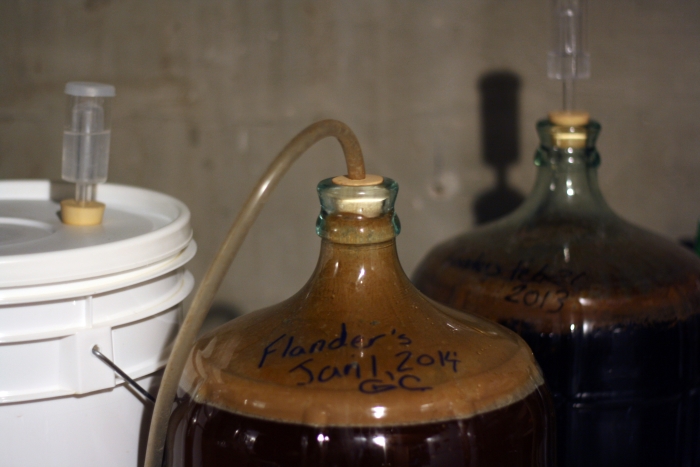Pucker up, it’s time for some sour beer. Out of the six BJCP recognized sour beers, I have only made a Flanders Red. The others include: Straight Lambic, Fruit Lambic, Berliner Weisse, Flanders Brown, and Gueuze.
A Flanders Red is described in the BJCP style guidelines as “a complex, sour, red wine-like Belgian style ale.” The ones that I have tried reminded me of sour cherry pie.
There are three major reasons why I haven’t made more sour ales: it can take two or more years for sour beers to reach readiness, my wife is not a fan of sour, and I’m afraid to infect my brew area.
So, how does a brewer make sour beer? Easy, you throw bacteria in it and wait. Well, not as easy as placing the fermentor by the cat litter box and hoping for tasty beer. Yeast manufacturers such as Wyeast laboratories package blends of yeasts and bugs (bacteria) together to create a nice mixture so you can make a tasty, infected beer.
Flanders Reds are starting to become more popular in the brewing world. Half Pints released their “Old Red Barn” last year. I remember standing in a block long line at 8 AM in a biting chill to get my three bottles of their limited release sour. When I think back, that Flanders was a lot more complex than my recently bottled sour. Mine, so far, is just a sour cherry blast. Of course, it will change over the years and I’m looking forward to trying it every couple of months to see how it matures.
A popular Flanders yeast blend is Wyeast’s Roesleare and that is what I used for all three Flanders that I have made. This blend is a secret formula and Wyeast only gives us the bare minimum: “Specific proportions of a Belgian style ale strain, a sherry strain, two Brettanomyces strains, a Lactobacillus culture, and a Pediococcus culture produce the desirable flavor components of these beers as they are brewed in West Flanders.”
Belgian style ale strain – Belgian yeast gives off an estery (fruity) aroma and flavour.
Sherry strain – The Sherry flor helps decrease the sugars in the beer to make it bone-dry. The flor will create a pellicle, which is a thin, unappealing, ivory layer of yeast that acts as protection from oxygen.
Two Brettanomyces strains- Brett is a wild yeast usually found on the skin of fruit. It adds a level of funk to the beer such as the unappetizing ‘horse-blanket’ smell.
Lactobacillus and Pediococcus culture – These bacteria are responsible for creating lactic acid. Yogurt, buttermilk and sour dough bread have lactic acid in them which causes their tart flavour. Lactobacillus takes a slower approach to making lactic acid but Pediococcus can be a bit of a beast by giving the beer a rancid butter taste. Luckily, time and Brett are able to clean up that off flavour.
—
A year ago, I made a 20 litre batch of Flanders. I first fermented it with a clean American yeast then transferred it into a secondary with a package of the Roesleare yeast. It sat in a dark corner for about 10 months. I threw in some organic pomegranate and tart cherry juice and let it sit for another month or so. At bottling time, I added some vanilla extract that I made by letting a vanilla bean soak in two ounces of vodka for a couple weeks.
About two weeks before I bottled that batch, I made a 40 litre batch of Flanders. I fermented half of it with American yeast, and the other half I pitched with the Roesleare yeast. Right after I bottled my beer, I dumped about ¾ of the yeast cake from the old batch and racked the batch with the American yeast into that glass carboy.
I transferred the batch with the Roesleare into a secondary, because according to Michael Tonsmeire, a sour beer expert, “The more dying yeast cells the souring beer is exposed to the more funky/rustic it will taste. (As yeast dies the cells rupture releasing fatty acids.) Lambics are traditionally aged on the yeast, which is part of the source of their unique character. Most sour beers are transferred after the brewer’s yeast is done. Some breweries filter or fine at this stage to minimize the yeast brought over.” I think that’s the main reason why my first batch is super sour.
This is the recipe I used:
The Forgotten (21 litres)
- 2.5 kg 2 row pale
- 1.5kg Vienna malt
- .38kg Flaked corn
- .37kg Honey malt
- .15kg Caraaroma
- .05kg Chocolate malt
- 16 g Fuggle hops @ 60 minutes
There are just enough hops in this recipe to take a bit of the sweetness out. Be careful with hops and sour beer because bitter and sour is not a good combo.
At present, I don’t believe there are any Flanders for sale at the MLCC. They used to carry Duchesse De Bourgogne with its nice balance of sourness and sweet fruit. In my opinion, that’s a nice starter sour. Half Pints’ Old Red Barn is more for the sour connoisseur but it’s still a great beer. My Flanders needs more aging before I can really judge it.
Next year, I plan to blend the two Flanders I have sitting in a dark corner in my basement to see if I can make an exceptional sour. I’ll report back.
–
Mark Borowski is a home brewer, and a father, and is looking for a job working with beer. Follow him on Twitter @oldblackbrew
